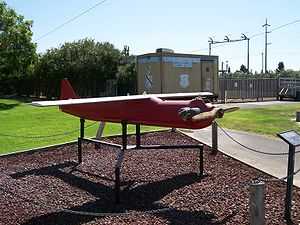Kawasaki KAQ-1
| KAQ-1 | |
|---|---|
 | |
| KAQ-1 on display at Castle Air Museum | |
| Role | Aerial Target Drone |
| Introduction | 1950s |
| Status | Retired |
| Primary user | United States, Japan |
|
| |
The Kawasaki KAQ-1 is a small, radio controlled target drone aircraft. A 72 horsepower (54 kW) engine allowed the KAQ-1 to reach speeds up to 220 mph (350 km/h) and fly for over 250 miles (400 km).
Purpose
The main purpose of the KAQ-1 drone was to train fighter pilots in the use of air-to-air missiles and to train anti-aircraft gunners on the ground. The KAQ-1 was launched from a ramp to known altitudes and if destroyed, a parachute rigged to the engine mounts would allow the engine to be recovered and reused. The drone was used in the 1950s by the armed forces of both the United States and Japan.
Specifications (KAQ-1)
Data from Data from Castle Air Museum's KAQ-1 web page. [1]
General characteristics
- Length: 12 ft 0 in (3.66 m)
- Wingspan: 11 ft 6 in (3.51 m)
- Height: 2 ft 7 in (0.79 m)
- Max takeoff weight: 342 lb (155 kg)
- Powerplant: 1 × McCulloch 4318A 4-cyl. air-cooled horizontally-opposed piston engine, 75 hp (56 kW)
Performance
- Maximum speed: 191 kn; 354 km/h (220 mph)
References
External links
| Wikimedia Commons has media related to Kawasaki KAQ-1. |
| ||||||||||||||||||||||||||